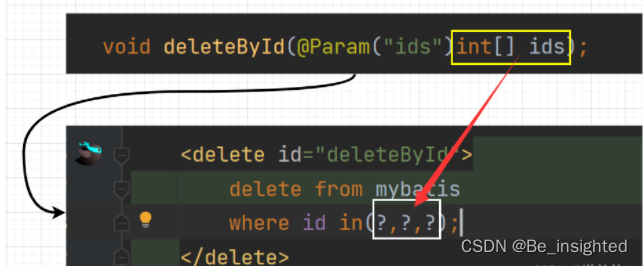mybatis复杂mapper之foreach、if、choose、when动态sql
foreach五大标签:item 表示集合中每一个元素进行迭代时的别名,随便起的变量名;index也就是索引,用于表示在迭代过程中,每次迭代到的位置;open 表示该语句以什么开始,常用“(”;separator表示在每次进行迭代之间以什么符号作为分隔符,常用“,”;close 表示以什么结束,常用“)”;collection该属性是必须指定的,但是在不同情况下,该属性的值是不一样的,默
复杂mapper之foreach、if、choose、when动态sql
foreach五大标签:
- item 表示集合中每一个元素进行迭代时的别名,随便起的变量名;
- index 也就是索引,用于表示在迭代过程中,每次迭代到的位置;
- open 表示该语句以什么开始,常用“(”;
- separator 表示在每次进行迭代之间以什么符号作为分隔符,常用“,”;
- close 表示以什么结束,常用“)”;
- collection 该属性是必须指定的,但是在不同情况下,该属性的值是不一样的,默认使用list
对于collection如果dao层接口没有用@Param注解时,默认使用list作为集合。如果是数组则为araary!
open、close、separate标签,不在标签中明确就得在mapper循环前后加上(),以及英文逗号
集合示例

<select id="findTotal" parameterType="java.util.ArrayList" resultType="long">
<!--select * from tab_route where cid = ? and rname like ? -->
select count(*) from tab_route where 1=1
<foreach collection="list" item="id" index="index" >
<if test="index==0" >
<if test="id!=0">
and cid= #{id}
</if>
</if>
</foreach>
<foreach collection="list" item="id" index="index" >
<if test="index==1" >
<if test="id!=null and id.length() > 0">
and rname like "%"#{id}"%"
</if>
</if>
</foreach>
</select>
数组示例

<select id="query" parameterType="Integer[]" resultType="Route">
<!--select * from t_route where cid = ? and rname like ? limit ? , ? -->
select * from t_route where 1=1
<foreach collection="array" item="id" index="index" >
<if test="index==0" >
<if test="id!=0">and cid =#{id}</if>
</if>
</foreach>
limit
<foreach collection="array" item="id" index="index" >
<if test="index==1" >#{id}</if>
</foreach>
,
<foreach collection="array" item="id" index="index" >
<if test="index==2" >#{id}</if>
</foreach>
</select>
choose、when、otherwise动态sql
<select id="UserActiveSearch_choose" parameterType="User" resultMap="UserVO">
SELECT
*
FROM t_user
<where>
<choose>
<when test="username != null and username != ''">
username = #{username}
</when>
<when test="email != null and email != ''">
AND email = #{email}
</when>
<otherwise>
AND id = #{id}
</otherwise>
</choose>
</where>
</select>trim

1.if-where
因为采用了Mapper代理开发,我们可以通过写xml的形式来编写我们的SQL,动态SQL的特性也就在这一举动中所蕴育,在原有的Mapper文件里我们进行如下改造,让平平无奇的SQL焕然一新:
<select id="selByCondition" resultMap="rm">
select *
from mybatis
<where>
<if test="status !=null">
and STATUS=#{STATUS}
</if>
<if test="companyName !=null and companyName !=''">
and company_name like #{companyName}
</if>
<if test="bracdName !=null and bracdName !=''">
and bracd_name like #{bracdName}
</if>
</where>
</select>
“<where>标签可以自动帮我们去掉and”,这样,不管查询的条件怎么变,我跟着这个逻辑流程走就不会出现SQL语法毛病而导致查询不出来的毛病啦,因为null的情况已经被if所过滤掉了,真是太哇塞了!
2.choose-when-ortherwise
对于从多个条件中选择一个的单条件查询的场景,利用分支嵌套就可以实现动态选择单条件:
在MyBatis的Mapper代理中,<choose>相当于switch,<when>相当于case
<select id="selByCondition2" resultMap="rm">
select *
from mybatis where
<choose>
<when test="status !=null">
STATUS=#{STATUS}
</when>
<when test="companyName !=null and companyName !=''">
company_name like #{companyName}
</when>
<when test="bracdName !=null and bracdName !=''">
bracd_name like #{bracdName}
</when>
<otherwise>1=1</otherwise>
</choose>
</select>
与多条件查询不同的是,SQL语句中只会有一个分支生效
当用户一个条件都不选时,可以在<otherwise>中写上1=1让语法成立,反之,若选择了条件则会返回正常结果
3.foreach
对于批量删除的场景,传统的方法是通过in关键字结合占位符来确定,就像这样
where id in (?,?,?)
但对于动态的场景,批量的数量永远是不确定的,这就导致还需要去改SQL里的占位符数量啊,又是一件麻烦事
PS:MyBatis会将数组参数封装成一个Map集合,默认情况(K-V)array=数组
下面使用了@Param注解改变了map集合中默认的key

于是MyBatis中的<foreach>解决了这一麻烦:
本质是通过遍历的形式,批量删除的数据是由id数组或者集合来决定,collection属性决定了要遍历哪个数组/集合,item属性则来存放选出的元素,并把它放在占位符里,separator属性表示分隔符
<delete id="deleteById">
delete frpm mybatis where id in
<foreach collection="ids" item="id" separator="," open="(" close=")">
#{id}
</foreach>;
</delete>
有人会问为啥这里只有一个#{id},我的属性字段不止这一个呀?此id非彼id他是一个数组/集合
三、多表操作
多表之间的关系有一对一,一对多,多对一,多对多,每一种都有建表的原则,以用户-订单模型为例
利用传统的方法进行多表查询无非是通过id来连接表然后封装返回结果,MyBatis中也是如此,我们在Mapper文件中写好表字段之间的映射关系,定义好类型即可,只不过这一过程有点复杂,但一次配好之后即可极大减少硬编码问题,提高效率
1.一对一
一个用户有一张订单

首先还是那套路,建好实体类,写好接口方法,配置Mapper文件,而多表操作的麻烦点就在于配置文件,这里通过例子细说一下
1.先把表写好
CREATE TABLE orders (
id INT PRIMARY KEY ,
ordertime VARCHAR(20) NOT NULL DEFAULT '',
total DOUBLE,
uid INT);
INSERT INTO orders VALUES(1,2020,2000,1);
INSERT INTO orders VALUES(2,2021,3000,2);
INSERT INTO orders VALUES(3,2022,4000,3);
CREATE TABLE USER (
id INT PRIMARY KEY ,
username VARCHAR(50) NOT NULL DEFAULT '',
passwords VARCHAR(50) NOT NULL DEFAULT '');
INSERT INTO USER VALUES(1,'lyy',333);
INSERT INTO USER VALUES(2,'myy',444);
INSERT INTO USER VALUES(3,'xyy',555);
2.写Mapper配置文件
在写实体类时,要把一个实体写到另一个实体的属性里面,这样才体现关联性,就比如“订单是所用户拥有的”,正因为这种关系我们才会在订单实体类里面写上private User user;这一属性,这样根据id连接的两个实体才能完美对接!
就像这样:

通过<association>把两张表对应的实体类连接起来,只不过是主键ID要用单独的标签
-
property: 当前实体(order)中的属性名称(private User user) -
javaType: 当前实体(order)中的属性的类型(User)
这两个user有着本质上的却别,就好像前者是在一个人的名字,后者正是被叫的那个人,MyBatis好像就利用了这一特性,通过标签的形式连接了两个实体
<select id="findAll" resultMap="orderMap">
SELECT *,o.id oid FROM orders o,USER u WHERE o.uid=u.id
</select>
SQL环节和原来没什么区别,同样也是通过resultMap把字段和属性映射封装
2.一对多
一个用户有多张订单

首先,在原有的User实体中得加上一个表示“用户有哪些订单的属性”private List<Order> orderList;,目的是为了把订单的信息封装到用户的这个属性里,在Mapper文件中体现:
<collection property="orderList" ofType="order">
<!--封装order的数据-->
<id column="oid" property="id"></id>
<result column="ordertime" property="ordertime"></result>
<result column="total" property="total"></result>
</collection>
-
property:集合名称,User实体中的orderlist属性 -
ofType:当前集合中的数据类型,就是order实体
然后就是写一对多的SQL:
<select id="findAll" resultMap="userMap">
SELECT *,o.id oid FROM USER u,orders o WHERE u.id=o.uid
</select>
总结来看,一对多相比于一对一就是在那个“一”中增添了封装“多”的属性而已,然后稍微调整一下SQL
3.多对多
多用户多角色

多对多的建表原则是引入一张中间表,用于维护外键,就是一张表通过中间表找到另一张表
和一对多的模型类似,先在User实体类中增添一个“用户具备哪些角色”的属性private List<Role> roleList;其次配置Mapper文件:
<collection property="roleList" ofType="role">
<id column="roleId" property="id"></id>
<result column="roleName" property="roleName"></result>
<result column="roleDesc" property="roleDesc"></result>
</collection>
多表的连接是靠的中间表,这点在Mapper文件中通过映射实现,具体是把两张外表的id(userId和roleId)在id标签中配置成同一个属性,就像这样:
<id column="userId" property="id"></id>
<id column="roleId" property="id"></id>
SQL环节就得用多对多的套路了
<select id="findUserAndRoleAll" resultMap="userRoleMap">
SELECT * FROM USER u,user-role ur,role r WHERE u.id=ur.userId AND ur.roleId=r.id
</select>
回想进行多表操作时MyBatis为我们带来了什么?他确实减少了很多硬编码,我每一次新的SQL只需要在标签里改几个属性就可以,只要理清字段与属性的映射关系,在MyBatis中进行多表操作就是一个“对号入座”
四、注解开发
针对于简单的CRUD注解开发可以极大地提升效率,顾名思义就是把SQL写在注解里
查询(@Select):
添加(@Insert):
修改(@Update):
删除(@Delete) : int [] ids 原始数组

更多推荐
 已为社区贡献12条内容
已为社区贡献12条内容









所有评论(0)